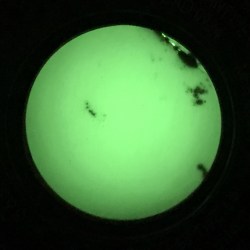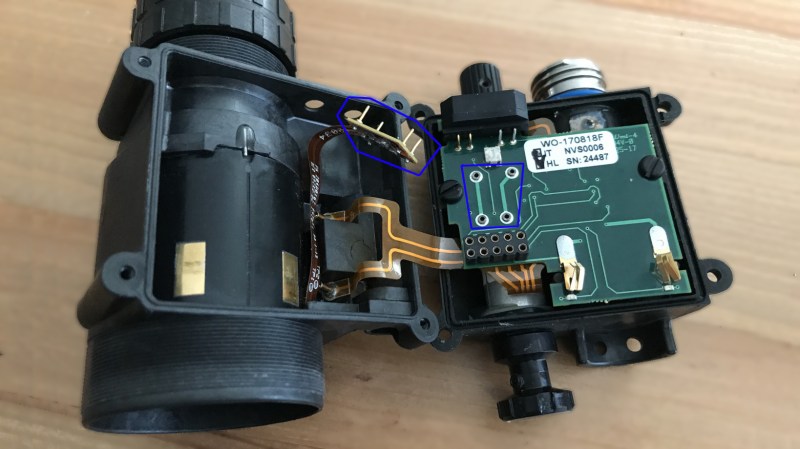[Nick Chen] shared some fascinating and useful details about building a AN/PVS-14 monocular night vision device from parts. It’s not cheap, but the build would be a simple one for most Hackaday readers, at least the ones who are residents of the USA. Since the PVS-14 is export controlled under the International Traffic in Arms Regulations (ITAR), parts are not sold outside of the US. Still, [Nick]’s illustrated build instructions provide a good look at what’s inside these rugged devices.
The build consists of purchasing a PVS-14 parts kit (or “housing kit”) which includes nearly everything except the image intensifier module, which must be purchased separately. Once all the parts are in hand, [Nick] explains how to assemble the pieces into a working unit.

Since the image intensifier is by far the most expensive component, there is an opportunity to save money by shopping for what [Nick] calls “blem” units. These units are functional, but have blemishes or dead spots within the field of view. The good news it that this makes them cheaper, and [Nick] points out that as long as the center region of the tube is clear, they are perfectly serviceable.
How much can one save by building from parts? [Nick] says buying a complete PVS-14 with a Gen 3 tube (sensitive to 450-950 nm) can cost between $2500 to $4000. It’s expensive equipment, no doubt, but deals can be found on the parts. Housing kits can be had for well under $1000, and [Nick] has purchased serviceable image intensifiers for between $500 and $1000. He says searching for “blem tubes” can help zero in on deals.
Knowing the right terms for searching is half the battle, and along with his build instructions (and a chunk of cash) a curious hacker would have all they need to make their own. Heck, build two because the PVS-14 is designed such that two units can be combined to make a binocular unit! Not ready to drop that kind of cash? Check out OpenScope, the open source digital night vision tool.
















There’s starlight-capable color sensors now: https://youtu.be/Mj-cyyuV0ck
The Chinese SmartSens image sensor company makes a very sensitive CMOS device (SC1020). With the right lens it produces an image in an environment that looks black to the human eye.
Website: http://www.smartsenstech.com
I tried buying it, it’s almost impossible. Best I could find were AVHD interfaced, pretty useless for anything but cctv cameras.
but you can’t buy them… the best you can get off the shelf is probably a Sony Alpha A7s (the “s” is important) camera…
Whoah.
“Hacker website releases plans for military-style assault NVG”
assault goggles … rofl
There’s some assumed knowledge in the article
-tubes can burn out when exposed to strong light. That’s what “autogated” tubes are meant to prevent
-gen 1/2/3 tubes have significant quality differences and corresponding price differences
-there’s also “Gen 1+” and “Gen 2+”. Plain gen 1 is garbo but 1+ is ok and affordable
-I believe the PVS-14 specifically has gen 2, 2+, and 3 tubes available
-the field of view is disappointingly small. Still useful, just not Splinter Cell
I mean the FOV is small on purpose. If you’ve got it mounted on your head, you don’t want your night vision to be compromised if something suddenly flares up, and conversely the FOV doesn’t matter when it’s mounted on a rifle because it’s the scope, not the NVG, that determines the effective FOV.
FOV is small for all traditional NVGs except for those stupidly expensive rigs with 4 tubes and prisms…
Interesting to have a look inside an application where solid state technology still isn’t competitive with vacuum tubes.
The same is true for film scanners. Photo Multiplier Tubes, as used in drum scanners, are superior to CCD designs. CCD’s are noisy and resolution limited. As a film user, I’ve been hoping someone might make a go at an open hardware PMT based scanner, and even considered starting a project.
But for film scanning you have one big advantage over night vision application: You can turn up the illumination at will. If you e.g. illuminate a 36*24mm frame with a 50W LED you have much more brightness than direct sunshine.
So I don’t see the advantage of using “hollow state” technology.
What rare and precious plastic or alloy is the housing made of to be worth a $1k minimum kit price? If cosmetic match to military contract is not required opaque PVC and some 3D printing to house electronics and mount the front and rear focus should do the trick. I would love a set of ANVIS, especially the 4 tube side vision sets, but the price even Russian stuff past Belorus 1g is too dear for a toy.
I imagine once the tube is made and passes all the adjustments and QA, it goes into a another manufacturing process where the housing is machined to maintain and ensure those adjustments with another QA process. They are built with Shock proofing, Water Resistance (maybe even water proofing up to 100 meters for Navy Seal) insulation for Heat Resistance would do well if the electronics get cooked or batteries freeze) well as preventing general handling and daily use to mess it up.
Don’t forget a Toilet costs 1000 dollars (bloat) and a single Screw for a Fighter (exact tolerances) can cost 60 if military procurement is involved.
The housing is more than just a plastic case. Its the optic lenses, power supply , switches, ir illuminator, battery box all in one package waiting to come alive when an intensifier tube is installed.
I have some Gen3 tubes at home that are permanently bonded to pointgrey firewire ccd cameras. They dont have a built in power supply like the ones here. I do have power supplies but they are a anodized aluminum box with everything potted in them. 4 wires, I think red, blue yellow and black? Anyone have any ideas? Thinking they were made by litton?
cut off the camera part? :D
I looked at that and there is a fiber optic condenser that is directly bonded to the CCD die of the camera. I sacrified one and tried to pull it off the sensor but the die just pulled out of the sensor package. I supposed I could diamond grind off the die and polish the fiber end.
But I am not worried about the camera part, the high voltage power supply for the tube is the issue.
stick a needle in each wire and put a scope to it?
Yes, the wouldve been made by L3 Electron Microdevices aka Litton
What about using some piezo transformer PCBs? Simple C/W multiplier on the output should work.
I think to remember, there was a Russian (gen 1 or less) NV device with a push button to operate the HV supply: It bend a piezo crystal to generate the HV.
On hackaday.io:
https://hackaday.io/project/10579-retro-futuristic-automobile-control-panel/log/44448-assistive-technologies-lets-improve-night-time-driving
https://hackaday.io/project/10579-retro-futuristic-automobile-control-panel/log/45561-assistive-technologies-building-cheap-night-time-vision-goggles
Neat build. The system opens another range of opportunities that can be visualized in more dimensions of detail. I think after watching the movie Predator, I’ve caught myself wondering what other images can be observed in different frequency ranges and may have had an earlier influence regarding my Dad mentioning things they can do from space that won’t be out for another 25 years or longer at least is what he was told in regards to military cycles disclosure. USAF seems to be more honest at least and not so guilty of compounding and concealing public service info… even when wrongful. I’ve been wondering what all is going on with other ranges in the 3D/4D image range of perceiving and especially after watching this video and wondering about beam focusing capabilities and max distance specs (t=246 or ~4:10 to get to the point of capabilities):
https://youtu.be/DZR13I_pxHY?t=246
Infrared can’t see Polar Bears. A Blem tube with 3 dots coming at you would be bad news.